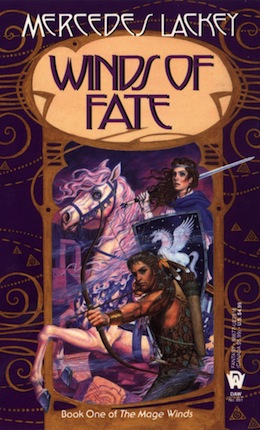Winds of Fate follows on the heels of By the Sword by picking up at the point where Elspeth becomes the acknowledged protagonist. She has been protagonisting covertly since the day she put a knife in Orthallen, an event she never speaks about. Observant readers might have noticed that Elspeth did not appear in the Last Herald Mage trilogy. But whatever. We knew how that story was going to end years in advance. The narrative purpose of that trilogy was to make sure we all know that Vanyel is one of Elspeth’s ancestors. Elspeth also played a minimal role in By the Sword, the book that ensured that she got a magic sword. Winds of Fate is the first book to deal directly with Elspeth being a Mage.
The book opens with Elspeth fending off an assassination attempt in her pottery studio. Faithful followers of the Valdemar re-read will have noticed that I am deeply suspicious of Companions. At this point, I suspect them of taking out the hit on Elspeth themselves. It’s not that the Companions want Elspeth dead. She is the prettiest princess in the land, and absolutely their favorite. They want her (and Gwena, her top-secret Grove Born Companion) packed off to Rethwellan to train her Mage-gift.
At minimum, the Companions must have manipulated a war in Karse, and possibly a boar-hunt in Rethwellan, to ensure the availability of a mercenary captain with personal connections to an ethically-appropriate school of Mages. One would think that arranging this would be as easy as pointing out that Elspeth is powerful enough to blow up the palace by accident, but it is evident that the Companions don’t want anyone knowing that Elspeth is a Mage until she’s fully trained. Even though they have to know that Hulda must have noticed. They just don’t want anyone other than Hulda knowing. A massive conspiracy of Companions talks all the Heralds into letting Elspeth ride off to Rethwellan to “find” a Mage who can tolerate Valdemar.
With Need on her hip, and her loyal friend Skif by her side, Elspeth rides across the Comb (it’s a mountain range) to Bolthaven to talk to some Mages. It’s not long before she’s dressed up like a mercenary and having the time of her life. Skif has undergone a tragic re-write, and has turned into a sulky hipster who pouts about being friendzoned. Old Skif was good for all your night-prowling, wall-climbing, knife-throwing needs, plus back rubs. He was a great guy to have on hand in a crisis. I miss him terribly. New Skif nearly sets fire to the Dhorisha Plains and then criticizes Elspeth for being too assertive. This is just one piece of the ongoing persecution of Elspeth, who is also at odds with her Companion. Gwena is a cheery little agent of someone’s plan to get Elspeth to Bolthaven, where Quenten will notice that Elspeth is crazy powerful and send her to Jendar, one of the adepts of the White Winds school who, it is anticipated, will train Elspeth and send her safely home. The plan falls apart in the middle because Gwena can’t stop humming. Instead, Elspeth gets the Tale’sedrin to give her a map of the Dhorisha Plains with directions to the nearest Tayledras Vale.
Readers are introduced to that Vale, k’Sheyna, through the viewpoint of one of its scouts, ex-Mage Darkwind. Darkwind disdains the artificial world within the Vale’s shields, its lack of connection to the surrounding natural environment, and the preoccupation of its resident Mages with isolating themselves from other Vales while they try to repair their flawed heartstone. He is every inch Rousseau’s noble savage, disdaining the corrupting influence of civilization while having sex in his hot tub. Darkwind also dabbles in fashion design and has daddy issues. His seventeen-year-old girlfriend literally turns into a bird and flies away just as Elspeth shows up.
This book either is your crack, or it isn’t. Darkwind’s father, Starblade, makes a compelling villain and then becomes convincingly sympathetic. The evil Mage, Mornelith Falconsbane is both ridiculous and truly menacing. While I don’t appreciate his fascination with sadomasochistic torture, I am a huge fan of the time he spends thinking about Velgarth’s ancient history. The relationship between the Shin’a’in, the Tayledras, and the Dhorisha Plains finally gets some attention. I know it’s incredibly important to many fans that the book features Gryphons. There are hints of Ancar’s continued involvement in Elspeth’s life. Mornelith’s slave, Nyara, is also introduced here, staking out the origin of her character arc and beginning her journey away from it.
Most excitingly, Need wakes up! And then she tells stories. Need was a swordsmith before the Mage Wars and nobly sacrificed herself to protect the sisters of her convent from a blood-path Mage. In keeping with my important role as Velgarth’s resident history nerd, I feel compelled to point out that this planet seems to have been technologically stagnant since the pre-Mage War period. To be fair, it might only seem that way—I was unable to determine whether or not Need’s convent had a hot water heater.
Now that we’ve moved on to whole books, I will not be posting about Valdemar every week. I don’t re-read that fast. Until next time, please share your favorite parts in the comments! Or your least favorite parts! Or your observations about common features of Velgarthian religious traditions! Hearing from you is my favorite part of this project.
Ellen Cheeseman-Meyer teaches history and reads a lot.










